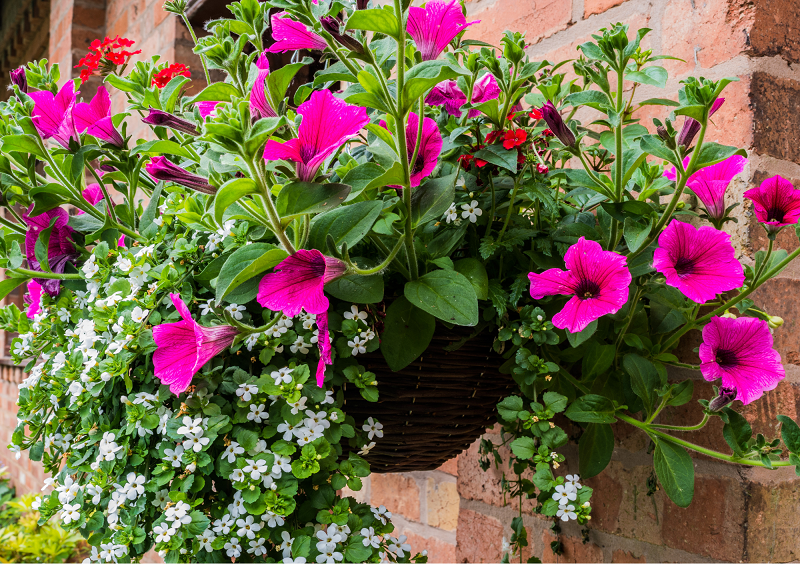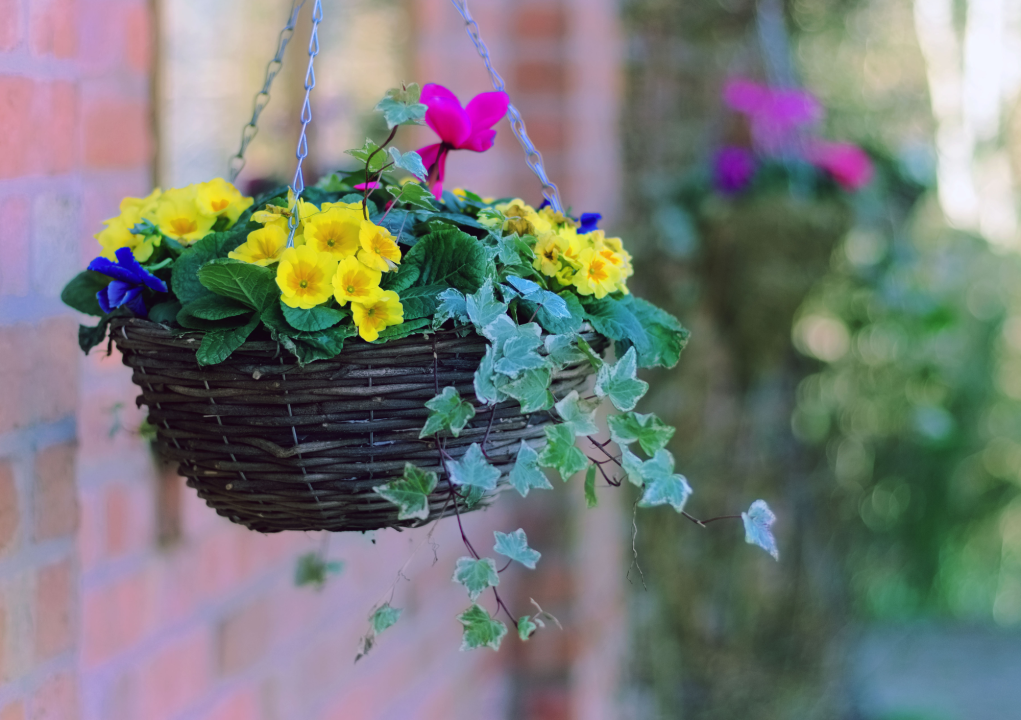Hanging baskets are a beautiful and colourful addition to any garden. Follow our guide and enjoy making your own this year!
Choosing your hanging basket
Make sure you visit M&C where you will find a large variety of different types and sizes of baskets to choose from, including plastic, rattan and metal. Remember you will also need a hanging basket bracket and this will have to be a size which corresponds with your choice of basket.
a hanging basket bracket and this will have to be a size which corresponds with your choice of basket.
How many plants will I need?
A general rule of thumb when creating a hanging basket is to use one plant per inch of basket diameter - so 12 plants per 30cm (12inch) hanging basket. The only exception is when using strong growing plants such as Fuchsias and Geraniums (Pelargoniums) - in this case it is best to only use 5 plants per 30cm (12inch) hanging basket. A 30cm (12 inch) container will comfortably accommodate about 6-8 plants.
Choosing plants for your hanging basket.
Choosing plants for baskets isn't east as there is such a wide choice but there are some key rules to creating a pretty and tasteful display. Avoid putting too many different plants with lots of contrasting colours together or your basket will end up looking like an over elaborate wedding cake. Keep your choice of plants simple by using colours that work together well, such as soft yellows, pinks and white or for something with a bit more zing, try different tones of red. When creating a hanging basket you will need several different types of plant. To give height on the centre of the basket choose Pelargoniums, Marguerites or Fuchsia. Lobelia, Pansies and Cineraria are great for filling in gaps, while Million Bells, Petunia and trailing Begonias can be planted at the edges to cascade over the sides of the baskets.
How to plant up a hanging basket
- Start by placing your empty hanging basket on a bucket so it is firmly in place whilst you add the plants.
- Adjust your chosen liner so it fits the basket snugly. Trim off any excess materials that protrudes above the rim. Using sharp scissors make a series of 5cm (2inch) slits in the sides of the basket liner to accommodate trailing plants. The trailing plants will eventually fill out and mask the wire frame. If the basket is deep enough, two layers of slits can be places around the bucket.
- Create a compost mix by adding 20% perlite to a multi-purpose compost. It is also a good idea to mix in some water-retaining granules and slow-release fertiliser to prevent baskets drying out quickly, and to feed plants through the summer season.

- Fill your basket with the compost mix until it is level with the first layer of slits and gently firm the compost down.
- Insert your trailing plants by pushing the plants head-first from the inside through the slits. To protect delicate young growth, try wrapping you plant loosely in polythene whilst you guide them through the holes; once the plant is in position with the root ball resting on the compost and the leaves on the outside remove the polythene.
- Continue to plant until all the slits have been filled and then gently tease out the roots of the plants. Add more compost and work it around the roots of the plants until the basket is almost full leaving a 1 inch gap below the rim.
- Plant further trailing plants around the rim - try and plant them so they grow in between the plants below. Choose a bushy upright plant for the centre. Fill in around the roots with further compost mix; aiming to keep the soil surface an inch below the rim of the basket to prevent compost spilling out when watering.
- To finish, water your hanging basket thoroughly with a fine-rose watering can and stand it in a greenhouse to grow on. If you don't have a greenhouse and your basket contains half-hardy plants, you will need to bring your basket undercover each evening to protect the plants from frost.
Looking after your hanging basket
When your plants have begun to fill the basket and the weather has started to warm up (about mid-May), place it outside during the day to harden off but bring it in at night, particularly if there is a risk of frost. Your plants will flower for much longer if they are deadheaded and, when cared for correctly, they should carry on flowering until the first frosts of autumn. It is also recommended to give the plants a liquid feed every 7 to 10 days.
Before hanging make sure the bracket is strong enough to take the full weight of the basket, especially when watered. Also, make sure to never let the plants dry out - they may need watering twice a day in the height of summer. If your basket has really dried out it could be very difficult to get it re-wet as the water will often run straight through the dried out compost. If this happens and your plants have keeled over it is possible to revive them by immersing the basket in a large bucket or bowl of water. Leave it submerged until no more bubbles are rising to the surface before taking it out to drain and hanging it back into position. Baskets treated in this way will usually recover but if it happens on a regular basis the plants will get stressed and eventually die.
